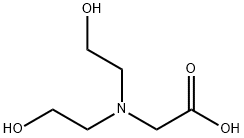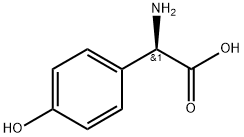Bicine
Synonym(s):N,N-Bis(2-hydroxyethyl)glycine;BICINE;N,N- bis-(2-Hydroxyethyl)glycine;N,N-bis-(2-Hydroxyethyl)glycine;N,N-Bis(2-hydroxyethyl) glycine
- CAS NO.:150-25-4
- Empirical Formula: C6H13NO4
- Molecular Weight: 163.17
- MDL number: MFCD00004295
- EINECS: 205-755-1
- SAFETY DATA SHEET (SDS)
- Update Date: 2024-12-18 14:15:32

What is Bicine?
Description
Bicine is an amino acid that results from amine degradation due to the presence of oxygen and/or sulfur dioxide. The amine solvents that undergo this degradation are MDEA, DEA, TEA, and mixed amine solvents containing any of these amines. As a zwitterionic amino acid buffer agent, bicine is active in the pH 7.6-9.0 range (pKa of 8.26 at 25°C). Bicine is a recommended buffer for low-temperature biochemical work. It is used for the preparation of stable substrate solution for serum guanase determination. It can be used as a nitrogenous strength enhancer to regulate cement hydration and improve cement properties. Studies have found that bicine significantly changes the morphology of portlandite crystals from a parallel-stacked lamellar shape to a distorted one and also decreases the pore size of the hardened cement paste at an early age[1]. In particular, bicine could promote the rapid formation of β-sheet-rich amyloid-β fibrils[2].
Chemical properties
Bicine is a white/clear crystalline powder that is somewhat soluble in water. It contains an amino group, carboxyl group, and two hydroxyl units in its structure, making it highly polar. It is often used as a biological buffer and chelating agent.
The Uses of Bicine
A zwitterionic amino acid buffer agent used for low temperature work. The use of bicine in a thin layer ion exchange chromatography method for protein resolution has been published. Bicine has been utilized in peptide and protein crystallization. A kinetic study of a quaternary transition-state analogue complex of creatine kinase used bicine in the reaction buffer. A multiphasic buffer system for SDS-PAGE of proteins and peptides that incorporates bicine has been described.
The Uses of Bicine
To prepare stable substrate solution for the determination of guanine deaminase. The buffer is widely used with the working concentration of 3-100mM.
What are the applications of Application
BICINE buffer Solution is 1 M in H2O, N,N-Bis(2-hydroxyethyl)glycine
What are the applications of Application
Bicine (cell culture suitable) is a zwitterionic amino acid buffer agent used for low temperature work
What are the applications of Application
Bicine is a zwitterionic amino acid buffer agent used for low temperature biochemical work in the 7.6 - 9.0 pH range.
Definition
ChEBI: N,N-bis(2-hydroxyethyl)glycine is a bicine that is a Good's buffer substance, pKa = 8.35 at 20 ℃. It is a conjugate acid of a [bis(2-hydroxyethyl)amino]acetate. It is a tautomer of a [bis(2-hydroxyethyl)ammonio]acetate.
Purification Methods
Dissolve bicine in a small volume of hot water and precipitate it with EtOH, twice. Repeat once more but treat the aqueous solution with charcoal Purification of Biochemicals — Amino Acids and Peptides and filter before adding EtOH. Also crystallise it from concentrated aqueous solutions. [Torn & Kolthoff J Am Chem Soc 77 2061 1955, Chaberek et al. J Am Chem Soc 75 2185 1953, Beilstein 4 IV 2390.]
References
[1] Lu X, et al. The influence of bicine on the hydration and properties of Portland cement. Journal of Thermal Analysis and Calorimetry, 2022; 147: 13125–13134.
[2] Kim H, et al. Bicine promotes rapid formation of β-sheet-rich amyloid-β fibrils. PLOS ONE, 2020.
Properties of Bicine
| Melting point: | 190 °C (dec.)(lit.) |
| Boiling point: | 290.25°C (rough estimate) |
| Density | 1.05 g/mL at 20 °C |
| vapor pressure | 0.002-0.007Pa at 20-25℃ |
| refractive index | 1.4240 (estimate) |
| storage temp. | room temp |
| solubility | H2O: 1 M at 20 °C, clear, colorless |
| form | Powder |
| color | White |
| PH | 4.0-5.5 (25℃, 1M in H2O) |
| pka | 8.3(at 25℃) |
| PH Range | 7.6 - 9.0 |
| Water Solubility | soluble |
| λmax | λ: 260 nm Amax: 0.070 λ: 280 nm Amax: 0.040 |
| Merck | 14,1201 |
| BRN | 1769362 |
| CAS DataBase Reference | 150-25-4(CAS DataBase Reference) |
| EPA Substance Registry System | Bicine (150-25-4) |
Safety information for Bicine
| Signal word | Warning |
| Pictogram(s) |
 Exclamation Mark Irritant GHS07 |
| GHS Hazard Statements |
H302:Acute toxicity,oral H315:Skin corrosion/irritation H319:Serious eye damage/eye irritation H332:Acute toxicity,inhalation H335:Specific target organ toxicity, single exposure;Respiratory tract irritation |
| Precautionary Statement Codes |
P261:Avoid breathing dust/fume/gas/mist/vapours/spray. P280:Wear protective gloves/protective clothing/eye protection/face protection. P305+P351+P338:IF IN EYES: Rinse cautiously with water for several minutes. Remove contact lenses, if present and easy to do. Continuerinsing. |
Computed Descriptors for Bicine
Bicine manufacturer
JSK Chemicals
ARRAKIS INDUSTRIES LLP
New Products
(S)-3-Aminobutanenitrile hydrochloride 4-Methylphenylacetic acid N-Boc-D-alaninol N-BOC-D/L-ALANINOL Tert-butyl bis(2-chloroethyl)carbamate 3-Morpholino-1-(4-nitrophenyl)-5,6-dihydropyridin- 2(1H)-one Furan-2,5-Dicarboxylic Acid Tropic acid 1-Bromo-3,5-Di-Tert-Butylbenzene S-2-CHLORO PROPIONIC ACID ETHYL ISOCYANOACETATE 2-Bromo-1,3-Bis(Dimethylamino)Trimethinium Hexafluorophosphate 4-IODO BENZOIC ACID 3-NITRO-2-METHYL ANILINE 1-(2,4-DICHLOROPHENYL) ETHANAMINE (2-Hydroxyphenyl)acetonitrile 4-Bromopyrazole 2-(Cyanocyclohexyl)acetic acid 4-methoxy-3,5-dinitropyridine 1-(4-(aminomethyl)benzyl)urea hydrochloride 2-aminopropyl benzoate hydrochloride diethyl 2-(2-((tertbutoxycarbonyl)amino) ethyl)malonate tert-butyl 4- (ureidomethyl)benzylcarbamate Ethyl-2-chloro((4-methoxyphenyl)hydrazono)acetateRelated products of tetrahydrofuran








You may like
-
 BICINE CAS 150-25-4View Details
BICINE CAS 150-25-4View Details
150-25-4 -
 N,N-Di(2-hydroxyethyl)glycine CAS 150-25-4View Details
N,N-Di(2-hydroxyethyl)glycine CAS 150-25-4View Details
150-25-4 -
 BICINE Buffer extrapure CAS 150-25-4View Details
BICINE Buffer extrapure CAS 150-25-4View Details
150-25-4 -
 Bicine 98% CAS 150-25-4View Details
Bicine 98% CAS 150-25-4View Details
150-25-4 -
 Bicine CAS 150-25-4View Details
Bicine CAS 150-25-4View Details
150-25-4 -
![N,N-Di(2-hydroxyethyl)glycine [Good's buffer component for biological research] CAS 150-25-4](https://img.chemicalbook.in//Content/image/CP5.jpg) N,N-Di(2-hydroxyethyl)glycine [Good's buffer component for biological research] CAS 150-25-4View Details
N,N-Di(2-hydroxyethyl)glycine [Good's buffer component for biological research] CAS 150-25-4View Details
150-25-4 -
 BICINE Extra Pure CAS 150-25-4View Details
BICINE Extra Pure CAS 150-25-4View Details
150-25-4 -
 N,N-Bis(2-hydroxyethyl) glycine CAS 150-25-4View Details
N,N-Bis(2-hydroxyethyl) glycine CAS 150-25-4View Details
150-25-4